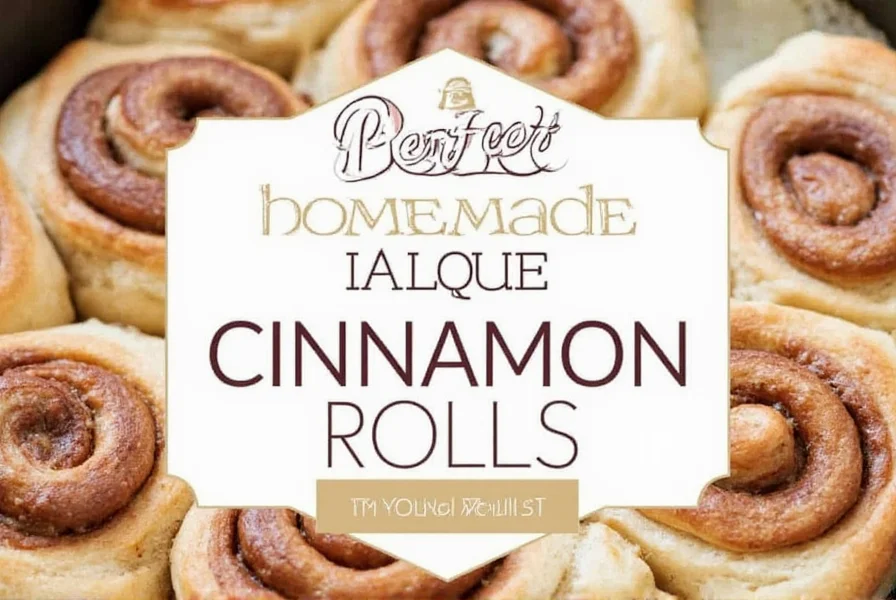The best homemade cinnamon rolls start with a soft, enriched yeast dough made with bread flour, fresh yeast, warm milk, butter, sugar, and eggs. After the dough rises, it's rolled out, generously coated with a buttery cinnamon-sugar filling, then sliced and baked until golden. The secret to perfect rolls is proper dough temperature (75-80°F), adequate proofing time (45-60 minutes), and using a combination of dark brown sugar and high-quality cinnamon in the filling. Finish with a smooth cream cheese frosting applied while rolls are still warm.
There's nothing quite like the aroma of freshly baked cinnamon rolls filling your kitchen on a weekend morning. While store-bought options exist, homemade cinnamon rolls offer superior texture, flavor, and that satisfying swirl everyone loves. Making them from scratch might seem intimidating, but with the right technique and ingredients, you can create bakery-quality rolls in your own kitchen.
Essential Ingredients for Perfect Cinnamon Rolls
The foundation of soft homemade cinnamon rolls begins with quality ingredients. Each component plays a specific role in creating that perfect balance of tender crumb and rich flavor.
Dough Ingredients
- Bread flour (3½ cups) - Higher protein content creates better structure
- Active dry yeast (2¼ teaspoons) - Freshness is critical for proper rising
- Whole milk (1 cup, warmed) - Should be 105-115°F for optimal yeast activation
- Unsalted butter (⅓ cup, melted) - Adds richness and tender texture
- Granulated sugar (⅓ cup) - Feeds the yeast and balances flavors
- Eggs (2 large) - Contribute to structure and golden color
- Salt (1½ teaspoons) - Enhances flavor and controls yeast activity
Cinnamon-Sugar Filling
- Unsalted butter (½ cup, softened) - Must be spreadable but not melted
- Dark brown sugar (1 cup, packed) - Creates that signature caramel note
- Ground cinnamon (2-3 tablespoons) - Use high-quality Saigon cinnamon for best flavor
- Nutmeg (¼ teaspoon, optional) - Adds complexity to the spice profile
| Ingredient | Critical Temperature | Why It Matters |
|---|---|---|
| Milk for dough | 105-115°F | Activates yeast without killing it |
| Dough during mixing | 75-80°F | Optimal temperature for gluten development |
| Proofing environment | 75-85°F | Allows proper rise without over-fermenting |
| Baked rolls internal temp | 190°F | Indicates perfect doneness without drying out |

Step-by-Step Guide to Making Homemade Cinnamon Rolls
Preparing the Dough
Start by warming your milk to 105-115°F. Sprinkle the yeast over the milk with 1 teaspoon of sugar and let it sit for 5-7 minutes until foamy. In a separate bowl, combine melted butter, remaining sugar, eggs, and salt. Once the yeast mixture is activated, combine both mixtures with 2 cups of bread flour.
Using a dough hook attachment on medium speed, gradually add remaining flour until the dough pulls away from the sides of the bowl. Knead for 5-7 minutes until smooth and elastic. The best homemade cinnamon rolls require proper gluten development, which you can test with the windowpane test: stretch a small piece of dough between your fingers—if it forms a translucent membrane without tearing, it's ready.
First Rise
Place the dough in a lightly greased bowl, turning to coat all sides. Cover with plastic wrap and a clean kitchen towel. Let rise in a warm spot (75-85°F) for 1-1.5 hours, or until doubled in size. Don't rush this step—proper fermentation develops flavor and texture.
Rolling and Filling
Once risen, punch down the dough and turn it out onto a lightly floured surface. Roll into a 16x21 inch rectangle. Spread softened butter evenly over the dough, leaving a ½ inch border. Mix brown sugar and cinnamon, then sprinkle evenly over the buttered surface.
This is where many easy homemade cinnamon rolls recipes go wrong—don't skimp on the filling! The generous cinnamon-sugar layer creates those beautiful swirls and rich flavor pockets. Roll the dough tightly from the long side, pinching the seam to seal. Using dental floss or a serrated knife, cut into 12 equal slices.

Proofing and Baking
Place rolls in a greased 9x13 inch baking dish, leaving space between them. Cover and let proof for 45-60 minutes until nearly doubled. The rolls should feel airy and spring back slowly when gently pressed.
Bake at 350°F for 22-28 minutes, until golden brown and an internal thermometer reads 190°F. Don't underbake—properly cooked rolls have a delicate crumb that holds together when pulled apart.
Cream Cheese Frosting Recipe
While rolls bake, prepare the frosting:
- Cream cheese (8 oz, softened)
- Unsalted butter (¼ cup, softened)
- Powdered sugar (2 cups)
- Vanilla extract (1 teaspoon)
- Salt (pinch)
Cream together cheese and butter until smooth. Gradually add powdered sugar, then vanilla and salt. Once rolls are slightly cooled (but still warm), spread frosting generously over the top. The warmth helps the frosting melt slightly into the rolls.
Troubleshooting Common Cinnamon Roll Problems
Dense rolls: Usually caused by too much flour, under-proofing, or old yeast. Measure flour correctly by spooning into measuring cups and leveling off—don't scoop directly.
Filling leaking out: Ensure your butter is spreadable but not melted, and don't overfill the edges. Chilling the rolled dough for 15 minutes before slicing can help prevent leakage.
Rolls spreading sideways: This happens when the dough hasn't been rolled tightly enough. When rolling, apply gentle but firm pressure to create a compact log.
Storage and Serving Tips
For best results, enjoy freshly baked cinnamon rolls the same day. Store leftovers in an airtight container at room temperature for up to 2 days. To refresh, microwave individual rolls for 10-15 seconds or warm in a 300°F oven for 5 minutes.
For make-ahead convenience, prepare the rolls through the cutting stage, then cover and refrigerate overnight. In the morning, let them come to room temperature and complete the proofing (about 30-45 minutes) before baking.











 浙公网安备
33010002000092号
浙公网安备
33010002000092号 浙B2-20120091-4
浙B2-20120091-4